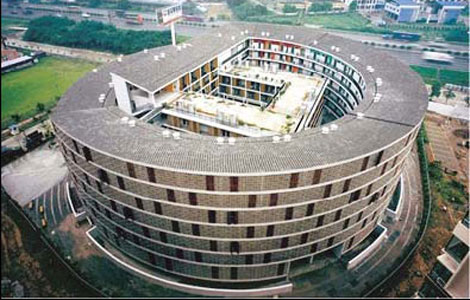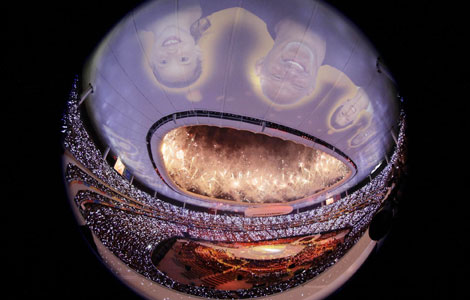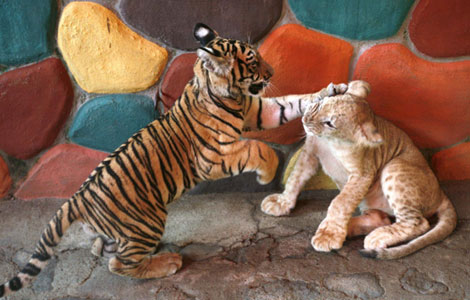Entering Forbidden City
Updated: 2011-10-16 10:49
(Xinhua)
|
|||||||||||
BEIJING - Wang Ge got lost during his first day of working in Beijing's Forbidden City, a palace over 500 years old, packed with some 9,000 rooms, high walls and labyrinthine passageways.
The Palace Museum, as it is also known, covers 720,000 square meters in the heart of China's capital and once housed 24 emperors of the Ming (1368-1644) and Qing (1644-1911) dynasties.
"In the darkness I could see nothing modern, only old walls and the roofs of halls. I had never felt so close to the ancients," Wang said of his first day working in the Palace Museum's exhibition department 11 years ago.
Like other museum staff, Wang rides a bicycle into the Forbidden City. Ordinary people were forbidden to get close to the palace during the imperial eras.
Although halls along the central axis and many of the main buildings in the Forbidden City have been opened to the public for years, most parts of the palace are used as offices or warehouses and have restricted entry for tourists.
Wang got an opportunity to go over these forbidden areas when he was assigned to draw an ichnography of the Palace Museum.
"I know which courtyard has the prettiest flowers, and which yard has the sweetest jujube," Wang recalled.
He enjoys feeding birds leftovers from his lunch, while cawing crows flying back to the palace at dusk signal the end of his workday.
In addition to birds, the Forbidden City is also home to snakes, rats, worms and ants. Wang said he has also seen lizards and bats in the past.
Wang said he can tell how long people have worked in the Forbidden City by the way they open doors.
"A bold young man will cross the threshold as soon as he opens a door, but an experienced worker will take a step back to avoid dust and anything else falling from the door. It's a weird, but reasonable habit formed in the palace," he said.
Wang has been transferred to the museum's publishing house of a monthly journal, "The Forbidden City", aims to introduce readers to the palace's history and culture.
Inspiration for a story struck while preparing for his wedding in 2006, and he compiled a special issue about the Qing Dynasty emperors' weddings, showing how much his life is influenced by his work in the palace.
"I won't get lost here any more. I feel my heart has been deeply rooted here, and I will never leave," Wang said.
From Forbidden City to Palace Museum
About 100 years ago, a young man, like Wang, rode a bicycle in the Forbidden City. This young man was China's last emperor, Aisin-Gioro Puyi. He ordered the thresholds of many gates in the palace to be sawed off, so he could ride his bike without any hurdles.
The Forbidden City, built in 1420, was the highest center of power for about 500 years, and occupying the palace was a symbol for ruling China.
Puyi ascended to power in 1908, and was forced to abdicate after the Xinhai Revolution in 1911. According to the articles of favorable treatment reached by the interim government of the Republic of China (ROC) and the Qing court, Puyi was allowed to continue living in the palace temporarily.
In a coup d'etat launched by warlord Feng Yuxiang in 1924, Puyi was forced to leave the Forbidden City. After that, scholars, government officials and some officials of the former Qing court formed the Committee for the Readjustment of the Affairs of the Qing House.
In order to prevent the restoration of the Qing Dynasty, the committee established the Palace Museum.
At the opening ceremony of the Palace Museum on October 10, 1925, the committee said, "From now on, this place belongs to all the people of China."
Although the former imperial palace is commonly referred to as the Forbidden City among foreigners, most Chinese know it as the Palace Museum.
"Turning from the Forbidden City to the Palace Museum is a symbol of epochal change," said Li Gongming, a professor with the art history department of the Guangzhou Academy of Fine Arts.
"From then on, fundamental changes happened to the imperial palace. Its connotation of political power was replaced by civil rights and cultural exchange," Li said.
After dramatic shifts from emperor to a puppet of Japanese aggressors, then from war criminal to ordinary citizen, Puyi revisited the former palace after being granted a special pardon in 1959.
In his autobiography "From Emperor to Citizen," Puyi wrote, "What I found most surprising was that the air of decay and collapse I had known there when I left had disappeared."
"In the imperial garden I saw children playing in the sun and old men sipping tea. I sniffed the spring fragrance of the ancient cypresses and felt that the sun was shining brighter here than it had ever done before. I was sure that the former palace had taken a new lease on life," Puyi wrote.
Hot Topics
Libya conflict, Gaddafi, Oil spill, Palace Museum scandal, Inflation, Japan's new PM, Trapped miners, Mooncake tax, Weekly photos, Hurricane Irene
Editor's Picks

|

|

|

|

|

|







